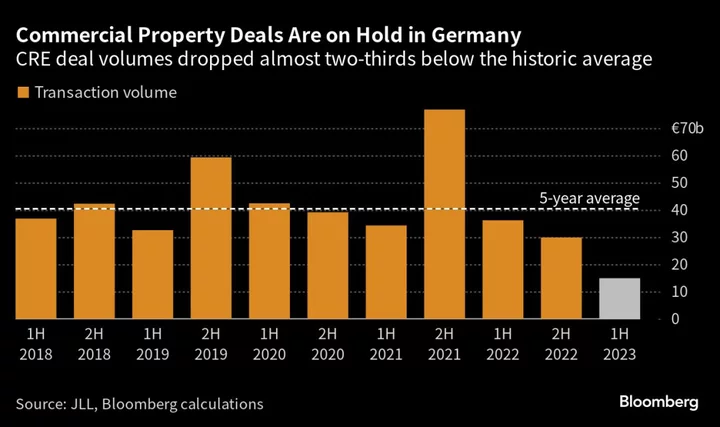The Canadian economy unexpectedly shed jobs last month even as wages grew faster, signaling a softening labor market that will likely pave the way for the Bank of Canada to hold rates steady.
The country lost 6,400 jobs in July, while the unemployment rate rose to 5.5%, the third straight monthly increase, Statistics Canada reported Friday in Ottawa. The figures missed the median estimate for a gain of 25,000 positions in a Bloomberg survey of economists, but matched expectations for the jobless rate.
Workers’ compensation, however, continues to rise. Wage growth reaccelerated to 5%, beating expectations for a 4.1% gain and up from 3.9% a month earlier. But the rest of the report suggested excess demand is easing, with two monthly job losses recorded in the three-month period from May to July.
“The soft July employment report is just the latest arrow in the quiver of signs that the economy is losing momentum,” Bank of Montreal Chief Economist Doug Porter said in a report to investors.
“The case for the Bank of Canada moving to the sidelines is now very strong,” he said, adding that while the central bank could be done tightening soon, firm wage growth and core inflation means interest rates are “likely to stay high for long.”
Traders pared bets that Governor Tiff Macklem will be forced to hike by another 25 basis points before ending his interest rate tightening cycle, with swaps markets putting the odds at less than two-thirds at the October meeting, from over 75% previously.
Government of Canada bonds rallied following the release — two-year yields fell to 4.600% as of 11 a.m. Toronto time.
July’s data, which followed a surprise gain of 59,900 jobs in June and 17,300 losses in May, shows an economy starting to gear down under the accumulated weight of 475 basis points of rate hikes. While firm economic data earlier this year prompted Macklem and his officials to raise rates in June and July after a five-month pause, recent indicators point to fading momentum.
So far this year, monthly employment growth has averaged 22,000 jobs.
“These ebbs and flows in the headline employment readings tend to occur around turning points,” said Royce Mendes, head of macro strategy at Desjardins Securities, in a report to investors. “The simple fact that the economy has seen employment decline in two out of the past three months suggests that the Bank of Canada’s efforts to rebalance the labor market are working.”
Evidence is mounting that the central bank can pause at its next meeting on Sept. 6. Manufacturing, wholesale and retail data pointed to declines in June, when preliminary data showed the economy shrank for the first time this year. Inflation in June slowed to 2.8%, entering the central bank’s control range for the first time since March 2021.
Policymakers are watching for signs that rates are restrictive enough to cool the economy, and they view wage growth of this magnitude as inconsistent with bringing inflation back to the 2% target. But despite recent large strikes by employees demanding higher compensation, further easing in overall wage growth could be on the horizon as high levels of immigration boost the pool of workers while demand slows.
Employment growth in the past year has occurred during a period of historically high population increases. From January to July, the employment rate fell 0.5 percentage points, as population growth of 1.4% outpaced an 0.7% gain in employment over this period.
“Controlling for a boost to the Canadian population, labor markets softened more significantly under the surface,” Carrie Freestone, an economist at Royal Bank of Canada, said in a report to investors. “Today’s jobs report is a point in favor of keeping the overnight rate at 5%, but the BoC will closely monitor additional indicators – particularly upcoming inflation and consumer spending reports – to determine whether an additional hike is needed.”
This is the only jobs report before the next rate decision, with another key data release for policymakers — July’s inflation print — coming Aug. 15. The majority of economists in a Bloomberg survey expect the bank to hold rates steady at 5%.
Last month, total hours worked were up 0.1% on a monthly basis and rose 2.1% compared to a year earlier. That points to relatively weaker economic momentum at the start of the third quarter, when economists surveyed by Bloomberg expect growth in gross domestic product to slow to 0.4%. Preliminary data indicated output growth slowed to 1% in the second quarter.
With the jobless rate in Canada rising steadily since May, the three-month moving average now stands at 5.37%, up from the 12-month low of 5%. According to a recession indicator created by US economist Claudia Sahm, once that rate rises half a percentage point or more, the economy is contracting. By that measure, if the unemployment rate holds or rises further over the next few months, it could signal Canada is entering a period of downturn.
The participation rate decreased 0.1 percentage point to 65.6%. The employment rate, or the employed proportion of the population aged 15 and older, was 62%, down 0.2 percentage points from a month earlier and little changed on a year-over-year basis.
Job losses were led by decreases in construction, public administration, information and recreation and transportation and warehousing.
Regionally, employment rose in Alberta, New Brunswick and Prince Edward Island, while it decreased in Manitoba and Saskatchewan and was little changed in the other provinces.
Separately on Friday, one of Canada’s biggest telecommunications firms, Telus Corp, announced that it’s seeking to reduce 6,000 staff globally.
--With assistance from Erik Hertzberg.
(Recasts the story from the top to add more context and Bank of Canada implications.)
Author: Randy Thanthong-Knight









